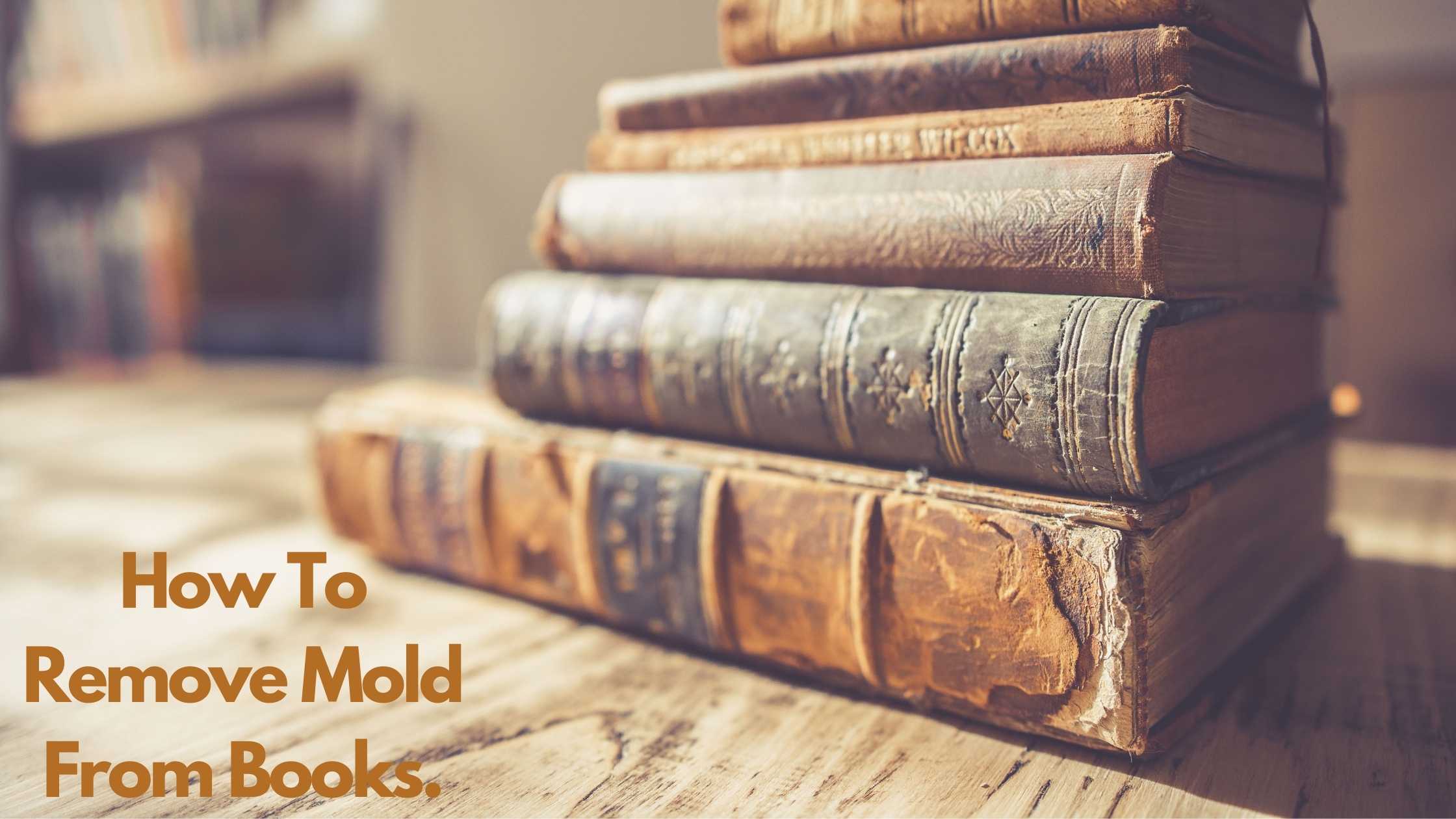
How to Remove Mold from Books (Step by Step)

It sucks to know that books by their very build are a prime breeding place for certain fungi like mold.
Luckily, it’s easy to remove mold from books that aren’t adversely affected, while some moldy books could require consistent interventions due to the books’ materials or damage level.
Because mold is harmful, it’s advisable not to rush the removal process. Instead, work on a plan that not only (hopefully) salvages your books but ensures you’re safe from infection.
Based on insightful data collected on this topic, this article details a step by step approach to removing mold from books.
And if you’d like to learn about selling your old books, check out this insightful piece.
Can mold be removed from books?
Yes, if the item is valuable and water-tolerant, careful, consistent cleaning can remove the mold. However, unlike mold on other surfaces like clothes, book mold is a much more complex problem. It’s costly, time-consuming and there are no guarantees in some cases that the mold will be eliminated.
Identifying mold and mildew on books
Before you start removing mold from books, it’s important to understand the type of fungus you’re dealing with.
Mold, as described by WebMD, is a fungus that consists of small organisms that are either black, white, orange, green, or purple and can thrive anywhere as long as there are adequate nourishment and just the right level of humidity.
They especially thrive in moisture and reproduce through lightweight spores that travel through the air. They’re quite harmless in small quantities but can be quite a hazard if left to collect en masse.
Mildew, on the other hand, shares a lot of similarities with mold and may in certain places even thrive with it, but they’re not the same type of fungus. Mildew grows on flat moist surfaces, and its damage isn’t quite as extensive. Mildew on books can be removed without much trouble.
The easiest way to identify mildew is through sight and smell. As it turns out, that old book smell you love so much is mostly mildew.
Want to know how to remove mildew from books? It’s not complicated and is done much in the same way you’d remove mold from books.
To learn more about how to clean moldy books, keep reading.
How to clean mold from book covers
The first thing to do is carry out an assessment of the books you plan to clean. Check where the mold is manifested and how widespread it is. Next, ensure that the book is completely dry. It will be futile to work on a wet book as this could end up damaging it irretrievably.
Once done with the book assessment, take personal precautions by seeing an MD to ascertain that you’re not allergic to the mold and can actually conduct the cleanup.
An alternative to this would be to hire a professional conservator, especially if the books are many and valuable.
But if you opt to DIY, here are some essential protective wearables to use.
- A respirator
- Safety glasses
- Disposable gloves
For the cleaning, get the following:
- A cleaning solution
- Dry pieces of cloth or wipes (not perfumed)
- Disinfectant
- Absorbent paper
- To begin, don’t attempt to do this indoors, instead carry the books you want to work on outdoors and let it be on an exceptionally dry sunny day. For efficacy, the cleaning process should be carried out in a shady area.
- Brush off dust and mold lodged on the book cover gently with the soft brush or blow it off with a vacuum.
- If you use cloth, only use disposable pieces, one for each book.
- Apply water or a cleaning solution sparingly on a sponge or soft cloth and wipe everything off slowly till it’s cleared off. You can also use alcohol because it acts fast and dries twice as fast. It works best with magazines and paperbacks.
- Once done cleaning, place the book on a flat surface to dry out for about an hour.
What to do if there is mold on the pages
Listen, if the book’s pages have mold, the book is valuable, and you can’t risk damage even by a whisker; it’s best to engage a professional.
If you opt to DIY, here’s the procedure you must follow:
- Take the books outside.
- Start by dusting each page very gently and slowly to avoid damaging any of them.
- Apply the cleaning solution sparingly on a dry piece of cloth and clean gently. Remember to use a different cloth for each page.
- To ensure that the pages don’t stick together, place absorbent papers in between the sheets.
- Wrap a dry towel around the book tightly and leave it to dry for not more than 10 minutes.
- Once done, spread out the book and leave it to dry for about an hour.
What to do if the book is wet — freeze it
Of all essential elements, moisture is the simplest and most universal requirement for mold to thrive. Without it, mold can’t access the nutrients in its food sources, such as paper.
Thus, the only way to halt the mold from surviving is by freezing the wet book. There’s a method to this approach and below are the steps to be taken.
Put it in a zip lock bag and place it in the freezer. If you’re using a household freezer, go for the frost-free option because ice crystals are also destructive. Set your freezer to its lowest setting—as in, the warmest temperature relative to how freezy it can possibly get—and keep checking frequently.
Freezing buys you time if you’re unable to air dry the book within 48 hours. For certain materials, immediate freezing is the only way to be certain that you’ll salvage the book. Freezing is recommended for leather, parchment, and rare books, glossy coated papers, and those with thinly applied soluble media.
Here’s how to dry the book.
- As the book thaws, place absorbent papers in between the book pages. Then wrap a dry towel around the book tightly, place a weight to ensure all the moisture is squeezed out. Use paper that’s larger than the book to accelerate drying.
- Keep checking without missing a beat to replace the absorbent paper and repeat the process until the book is damp.
- Use a fan or hair dryer to speed the drying process but be careful not to direct the air at the book for an extended period as it can cause deformation.
- Once done airing, leave it out to dry for about an hour.
How to Prevent Mold and Mildew Growing on Books
By now, you’re aware that humidity is mold and mildew’s best pal. Humidity enables them to grow and spread in their destructive ways.
To know how to keep them off completely, here’s what you need to do.
- Ensure your books are well lined on a shelf that receives adequate air circulation. You can ensure good airflow by using an air conditioner in summer and a heater in winter to maintain temperatures at 70 degrees Fahrenheit (21 degrees Celsius).
- While houseplants are a fantastic addition to a room, your library might be better off without them; or at least keep them away from the bookshelves. The houseplants soil is notorious for mold because its moisture encourages mold growth.
- Create a cleaning routine to regularly dust your books to avoid them becoming a collection point for mold spores.
Once you’ve cleaned your mold from your books, you’ll probably want to sell them and make some extra cash. Here’s a list of websites where you can sell your books. And you can also sell them to bookstores. Find out how much the bookstores will pay here.
Whenever you’re ready to sell, Sheepbuy is a great place to list your books. Our basic tier is perfect for those who have few books to list; you can have up to three active listings at any given time, at no cost. We also don’t charge a commission on sales, and there are no premium store fees. Learn more about Sheepbuy here.
Conclusion
How do you clean mold off books? With luck, after reading this article, this isn’t going to be an issue that gives you a headache anymore.
Removing mold from books is a step by step process that needs careful assessment before undertaking. Once you start, clean consistently and gently with a soft brush, cloth, and approved cleaning solution, then leave the book out to dry for at least an hour.
Happy cleaning, and good luck!
TRENDING


Online Arbitrage for Beginners (Step-by-Step Guide)

17 Types of Arbitrage Strategies to Turn a Profit

Is Retail Arbitrage Legal?

How to Turn Textbook Arbitrage into a Business for Profit

How Can You Tell if a Book is a First Edition?

What to Do With Your Jigsaw Puzzle When Finished?

